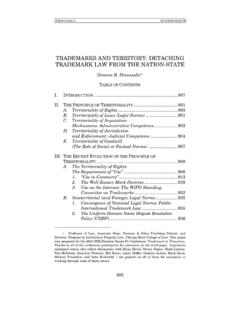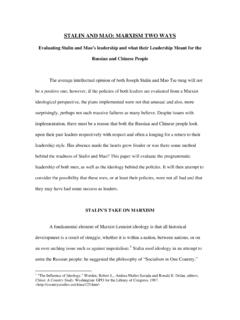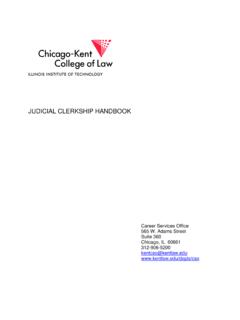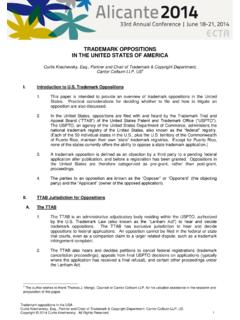Transcription of Expanding U.S. Trademark Protection for Celebrities ...
1 Expanding Trademark Protection for Celebrities Characters and Faces: The Effect on the Paparazzi and Mainstream Media By: Elsie Washington Introduction There is currently no comprehensive legal Protection for Celebrities characters or faces ( a photo) under United States Trademark law. Celebrities have relied on state privacy statutes and/or the federal cause of action of unfair competition, which derives from 15 1125(a), known as section 43(a) of the Lanham Act. They have also utilized the right of publicity as a basis for bringing a cause of action against persons or entities that have commercialized and financially benefited from use of their photo or character .
2 Nevertheless, Celebrities currently cannot register their characters or faces as a Trademark or bring a cause of action under 15 1065 unless they are associated with, or affixed to, a product or its packaging. As a result of the inability to register their characters or faces as a Trademark without such association, several commercial developments have occurred that are questionable as to whether they violate the rights of Celebrities . First, independent photographers, also known as paparazzi, take, print, distribute and sell photos of Celebrities for their own monetary benefit.
3 Second, the mainstream media also commercially benefits from these photos by purchasing them from the paparazzi and using them for their own economic growth as well as to compete with tabloids. Lastly, Celebrities do not directly benefit financially from the use of their photo in tabloids or in the mainstream media. This paper examines the approaches courts have used to deny celebrity s Protection of their photographs under the Lanham Act and the First Amendment liberties of the paparazzi and mainstream media.
4 The paper attempts to formulate a better framework for balancing the 2 competing interests that arise in such situations. It then further articulates factors based on a celebrity s level of fame and the federal Trademark law for courts to consider when determining whether the use of a celebrity s photograph should be protected and use of it is an infringement of their rights. Part I gives a brief overview of the Trademark Law and the lack of success Celebrities have had in bringing claims for Trademark infringement.
5 Part II of this paper discusses the value of celebrity photographs and the influence their fame and public image has over American popular culture. Part III describes briefly the effect of Celebrities failure to Trademark their photographs. It goes on to propose an option for Expanding the current Trademark law in order to deter unauthorized use of celebrity photographs and characters and allow Celebrities to control the use of his/her trademarked photograph. Moreover, it entertains the effect of the expansion on the paparazzi and mainstream media, counter-arguments of expansion, and opposing views regarding the benefits that Celebrities may experience from the tabloids and media attention.
6 Part IV overviews various Trademark laws outside of the pertaining to Protection of celebrity photographs in an attempt to contrast the reasoning used to pass such laws versus the denying the same Protection . The paper concludes with a summary of the recommended expansion of Trademark Protection and challenges the counter-arguments. I. Trademark Law A. Trademark Protection and the Lanham Act Trademarks are governed by both state and federal law. Originally, state common law provided the main source of Protection for trademarks; however, in the late 1800s, the Congress enacted the first federal Trademark law.
7 Since then, federal Trademark law has 3 consistently expanded, taking over much of the ground initially covered by state common law. The main federal statute is the Lanham Act, which was enacted in 1946 and most recently amended in Today, federal law provides the main, and by and large the most extensive, source of Trademark Protection , although state common law actions are still available. Most of the discussion in this paper focuses on federal law. A Trademark can be almost anything as long as it helps the consumer identify the particular product or service.
8 It can be a word, phrase, symbol, image, sound, device, or even Section 43(a) of the Lanham Act defines a Trademark as including "any word, name, symbol, or device, or any combination thereof" used by a person "to identify and distinguish his or her goods .. from those manufactured or sold by others and to indicate the source of the goods, even if that source is unknown."3 Examples include such marks as the Nike swoosh, the NBC three-toned chime G E C, and the distinctive shape of a Coca-Cola The essence of a Trademark is a designation in the form of a distinguishing name, symbol or device which is used to identify a person's goods and distinguish them from the goods of Normally, a mark for goods appears on the product or on its packaging, while a service mark appears in advertising for the services.
9 In addition, a "tm" on a product indicates unregistered Trademark rights and an " " indicates a registered mark. It is illegal to place an " " on a mark that does not have national registration. In order to receive a registration, a mark must fall into one of several categories: arbitrary or fanciful, suggestive, or 1 15 1051, et seq. (2010). 2 #what_kind. 3 15 1127 (2010). 4 #8. 5 ETW Corp. v. Jireh Publ'g, Inc., 332 915, 921 (6th Cir. 2003).
10 6 4 a. Arbitrary and Fanciful Marks: these marks are most easily registered are those which are arbitrary or fanciful. These marks are those that have no obvious association with a particular good or service and do not require secondary meaning. Yahoo is a perfect example of a fanciful mark. Blue Diamond Almonds is an example of an arbitrary mark. b. Suggestive Marks: these marks are next most easily registered but require the consumer to give some thought to understand the association. For example, a Greyhound Bus is suggestive because a consumer must think about the characteristics of a greyhound, fast, sleek and associate them with the bus service.
















